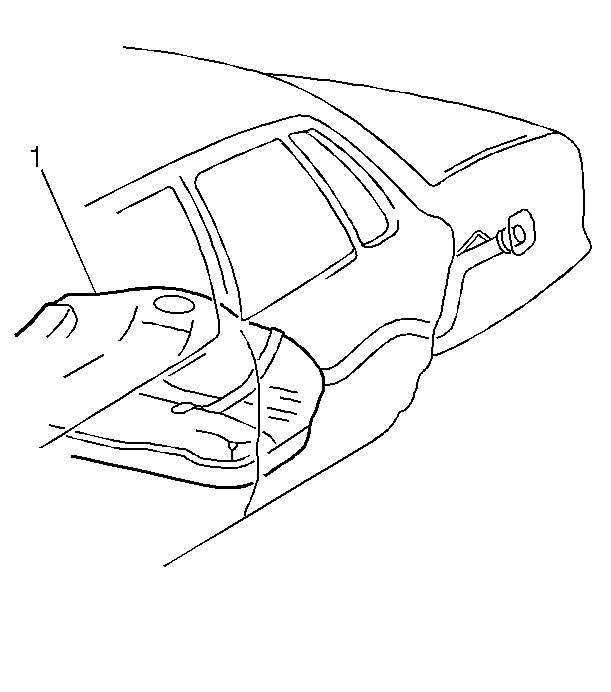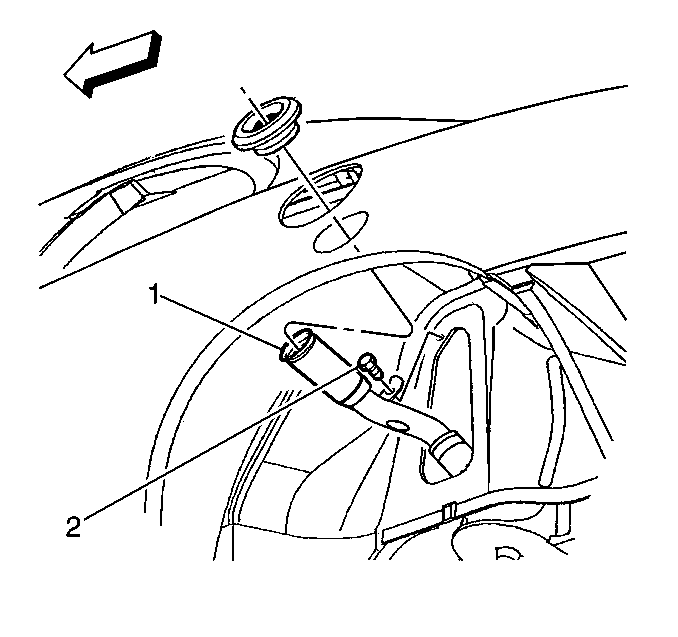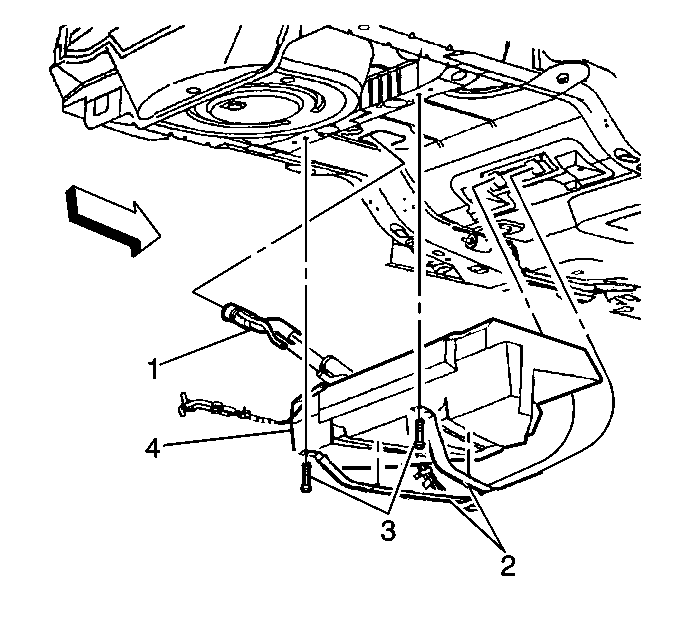Fuel Tank Replacement Replacement
Removal Procedure
Tools Required
J 39765 Fuel Sender
Lock Nut Wrench, J 37088-A
,
Fuel Line Quick-Connect Separator Tool Set

- Relieve the fuel system fuel pressure. Refer to the
Fuel Pressure Relief
.
- Drain the fuel tank (1). Refer to
Fuel Tank Draining
.
- Raise the vehicle.

- Remove the exhaust system. Refer to Exhaust System.
- Remove the wheel house filler pipe (1) opening cover in order
to gain access to the fuel tank filler pipe.
- Remove the fuel tank filler pipe attaching screws (2).

- Remove the fuel tank filler pipe (1) hose clamps and the fuel tank filler
pipe.
- Remove the height sensor connector. Remove the height sensor if
necessary. Refer to Electronic Level Control System.
- Remove the fuel feed, fuel return, and vapor pipes near the fuel
filter, refer to
Servicing Quick Connect Fittings
.
- Remove the EVAP pipes and retainers at the evaporative emission
canister.
- Remove the rear suspension support assembly. Refer to Rear Suspension.
- Remove the fuel tank bolts (3) from the fuel tank (2) straps.
- Remove the fuel tank from the vehicle and place the fuel tank
in a suitable work area.
Disassemble Procedure

- If the fuel tank is not being replaced, go to Installation Procedure.
- Disassemble the harness retaining straps (2).
- Disassemble the fuel feed, fuel return, and EVAP hoses.
- Disassemble the fuel sender assembly. Refer to
Fuel Sender Assembly Replacement
.
Assemble Procedure

- Assemble the fuel sender assembly. Refer to
Fuel Sender Assembly Replacement
.
- Assemble the fuel feed, fuel return, and EVAP hoses.
- Assemble the harness retaining straps (2).
- Assemble the fuel tank filler pipe and fuel tank filler pipe clamps.
Installation Procedure

Notice: Use the correct fastener in the correct location. Replacement fasteners
must be the correct part number for that application. Fasteners requiring
replacement or fasteners requiring the use of thread locking compound or sealant
are identified in the service procedure. Do not use paints, lubricants, or
corrosion inhibitors on fasteners or fastener joint surfaces unless specified.
These coatings affect fastener torque and joint clamping force and may damage
the fastener. Use the correct tightening sequence and specifications when
installing fasteners in order to avoid damage to parts and systems.
- Position and support the fuel tank (4) with the aid of an assistant.
- Install the fuel tank straps (2).
Tighten
Tighten the fuel tank strap bolts (3). Tighten the bolts to 48 N·m
(35 lb ft).
- Install the rear suspension support assembly bolts and the lower
suspension support assembly. Refer to Rear Suspension.
- Install the EVAP pipes and retainers at the evaporative emission
canister.
- Install the fuel feed, fuel return, and vapor pipes near the fuel
filter. Refer to
Servicing Quick Connect Fittings
.
- Install the fuel tank filler pipe hose clamps and the fuel tank
filler pipe.
- Install the height sensor connector. Refer to Electronic Level
Control System.

- Install the fuel tank filler pipe (1) attaching screws (2).
- Install the wheel house filler pipe opening cover.
- Install the exhaust system. Refer to Exhaust System.
- Lower the vehicle.
- Add fuel and install the fuel tank filler pipe (1) cap.
- Install the negative battery cable.
- Inspect for leaks.
| 14.1. | Turn the ignition switch to the ON position for 2 seconds. |
| 14.2. | Turn the ignition switch to the OFF for 10 seconds. |
| 14.3. | Turn the ignition switch to the ON position. |
| 14.4. | Check for fuel leaks. |







